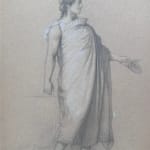Jean Auguste Dominique INGRES (Montauban 1780 – 1867 Paris)
30 x 18 cm
Provenance
Private collection, FranceThis standing male figure, shown in left profile, wears a classical chlamys and laced sandals. He holds a round painter’s palette in one hand and a bundle of brushes in the other — unmistakable symbols of the artist’s profession. The character clearly represents Apelles, the legendary Greek painter featured among the artistic geniuses paying homage to Homer in Ingres’s celebrated canvas The Apotheosis of Homer (Louvre, INV 5417, Salon of 1827).
However, the drawing does not appear to be a preparatory study for the 1827 painting, nor for the grand graphite composition completed in 1865 (Homer Deified, Louvre, Department of Prints and Drawings). Instead, this is likely a later independent reprise, executed around 1860, in the final years of the artist’s life. The technique — softened lines, diffused contours, sculpted light — corresponds to Ingres’s mature style.
On the inscription “à Mr Visconti”
The dedication may represent a posthumous tribute to Louis-Tullius Visconti (1791–1853), architect to Napoleon III and fellow member of the Institut de France. A close contemporary and admirer of classical antiquity, Visconti shared many aesthetic affinities with Ingres. Rather than a gift made during his lifetime, the inscription could thus mark a symbolic homage — Ingres offering the figure of Apelles, a mirror of the inspired artist, in memory of his deceased peer.
We warmly thank Professor Sylvain Bédard (Université de Montréal) for his valuable insights, which greatly contributed to the understanding and writing of this notice.
Join our mailing list
Join our mailing list to stay informed about our latest discoveries and upcoming exhibitions (once a month).
* denotes required fields
We will process the personal data you have supplied in accordance with our privacy policy (available on request). You can unsubscribe or change your preferences at any time by clicking the link in our emails.



